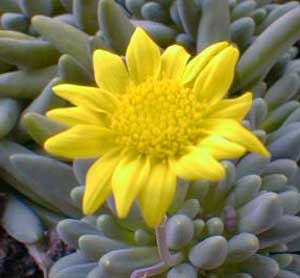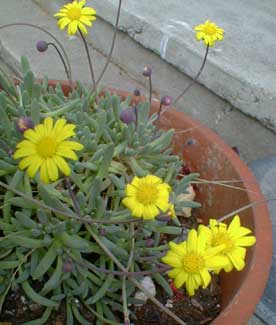
Little Pickles,
Yellow Iceplant
or, Cape Aster
'Tis but a little faded flower,
But oh, how fondly dear!
'T will bring me back one golden hour,
Through many a weary year.
I may not to the world impart
The secret of its power,
But treasured in my inmost heart,
I keep my faded flower.
-Ellen Clementine Howarth
(1827-1899)
(1827-1899)
'Little Pickles' Iceplant was named with quite the sense of humor, since the bluish-green succulent leaves of Othonna capensis do look a bit like baby gerkins, though lacking warts so that they might as easily have been named Wee Green Bananas.
 There is a risk of rotting out of the garden during wet winters, so it must be located where drainage is sharp & prestine, such as a rocky ledge, or in very light sandy soil, possibly under the eaves of a house. Outside of winter, it can tolerate, but does not need, some watering. Ours is in a large pot sitting on the front staircase in full sun, together with pots of the iceplants Delosperma herbeum with little white wood-aster flowers, & D. nubigenum or hardy yellow Bastutoland Iceplant.
There is a risk of rotting out of the garden during wet winters, so it must be located where drainage is sharp & prestine, such as a rocky ledge, or in very light sandy soil, possibly under the eaves of a house. Outside of winter, it can tolerate, but does not need, some watering. Ours is in a large pot sitting on the front staircase in full sun, together with pots of the iceplants Delosperma herbeum with little white wood-aster flowers, & D. nubigenum or hardy yellow Bastutoland Iceplant.Barring wetness, this hardy white iceplant will do fine here on Puget Sound (Zone 8). Though it is only cold-hardy in the range of ten to twenty degrees F., there are reports of gardeners keeping it going even in Zone 5. Further south it can be aggressive in the rockery & may require barriers of one kind or another not to displace nearby succulent groundcovers such as sedums.
Very similar to Delosperma species, O. capensis is likewise from South Africa. The select strain of 'Little Pickles' available in the nursery trade came originally from a private sun-garden in the Drakenberg Mountains, which the Zulu call the Barrier of Spears.
It requires full sun. It's dollhouse-sized sunflowers are bright yellow. These close in a wilty pose on overcast days or when the sun is not directly on them, so it should be given the sunniest of sunny exposures so that the flowers are open morning & afternoon.
The seeds produced by the flowers of 'Little Pickles' tend to be sterile, but the plant is easily propogated from the individual leaves. Blooms can start as early as mid or late April, & will persist the whole of summer, making rather more pleasing than the hardy yellow iceplant D. nubigenum which blooms for only a month.
While the foliage is only two or three inches tall, the flowers raise up on short stems to as high as four inches. It is everblooming from Spring to Autumn, minimally from April to September; here in Zone 8 it blooms at least until October.
That iceplants have flowers that look like daisies or asters is unexpected on what looks like a cactus relative, but Othonno & Delosperma species are indeed of the world's largest family of flowers, Asteraceae, which includes besides these succulents, daisies, mums, asters, sunflowers, dahleas & even dandylions.